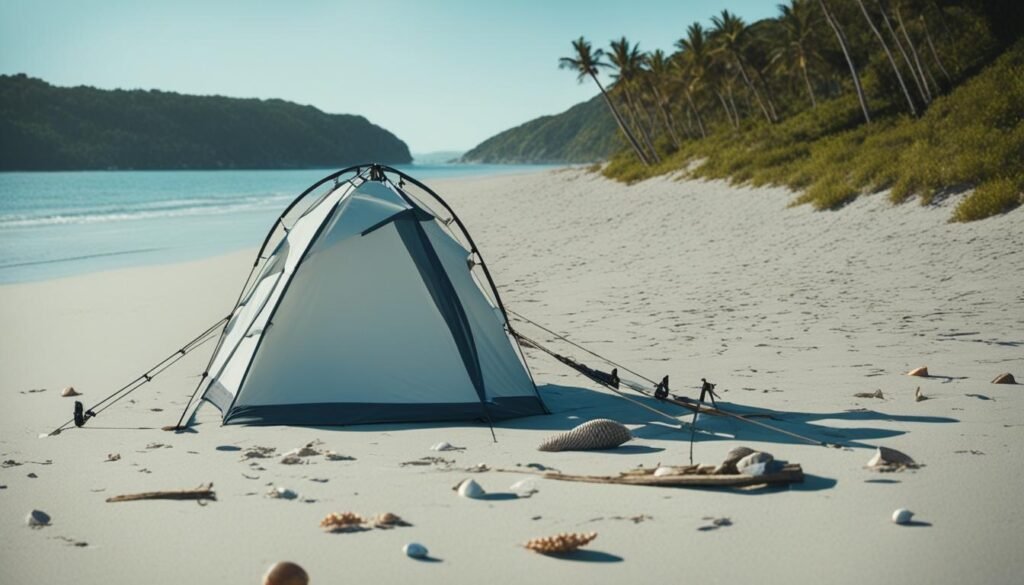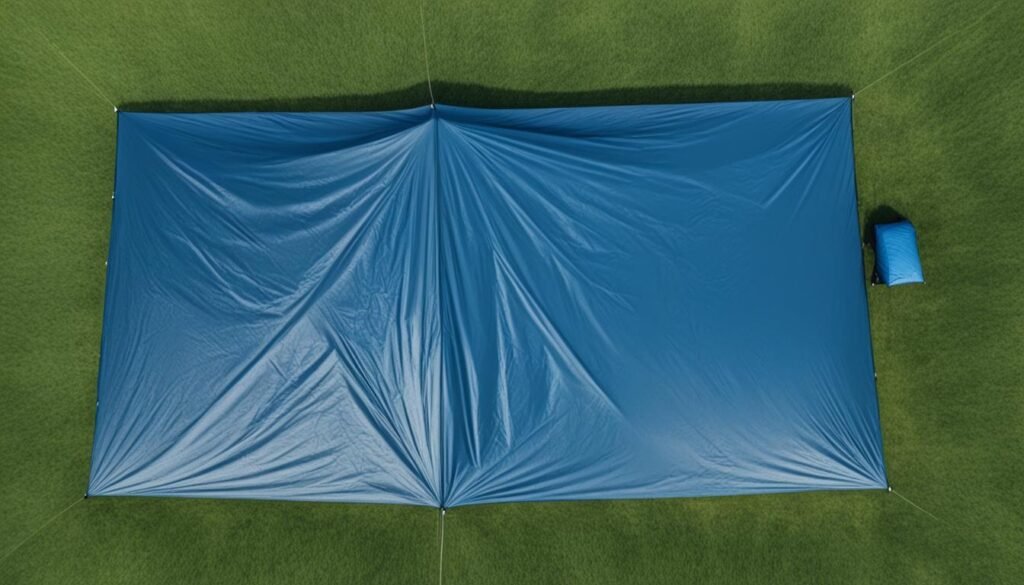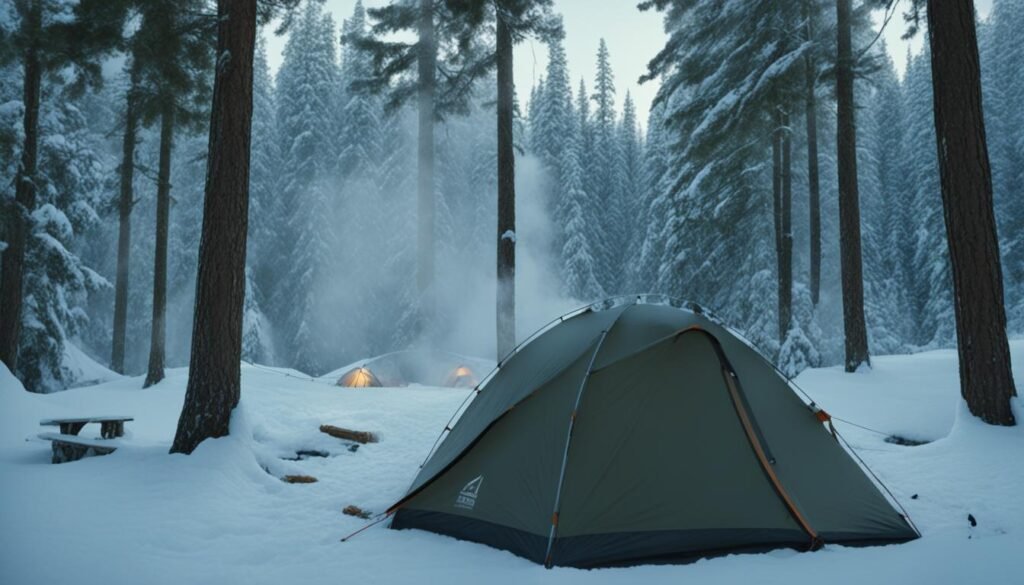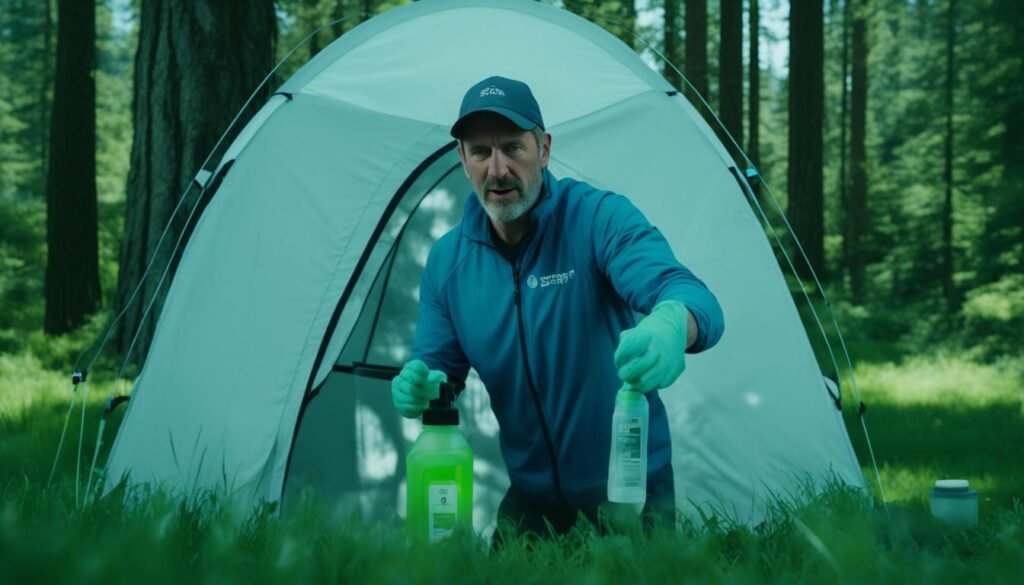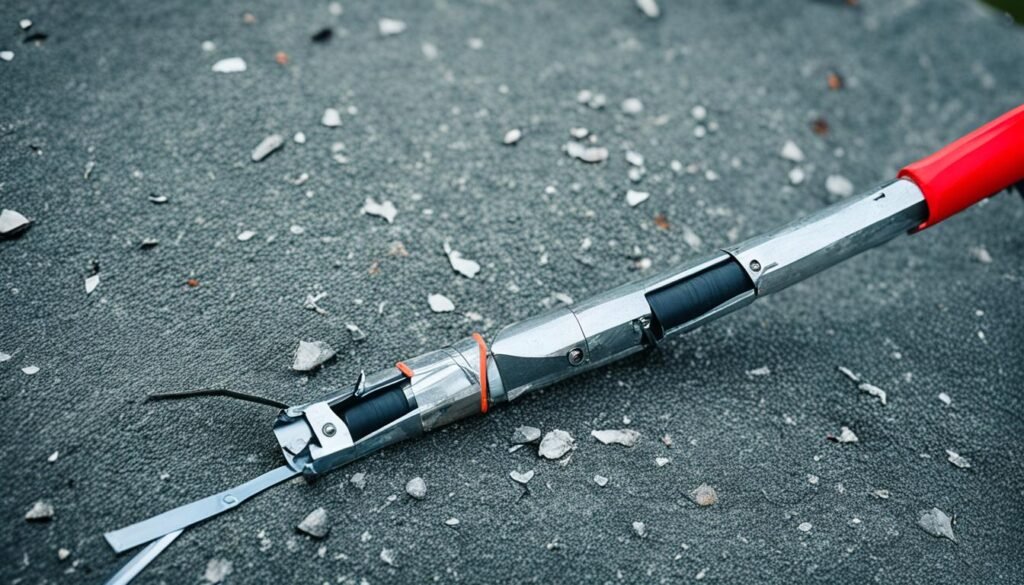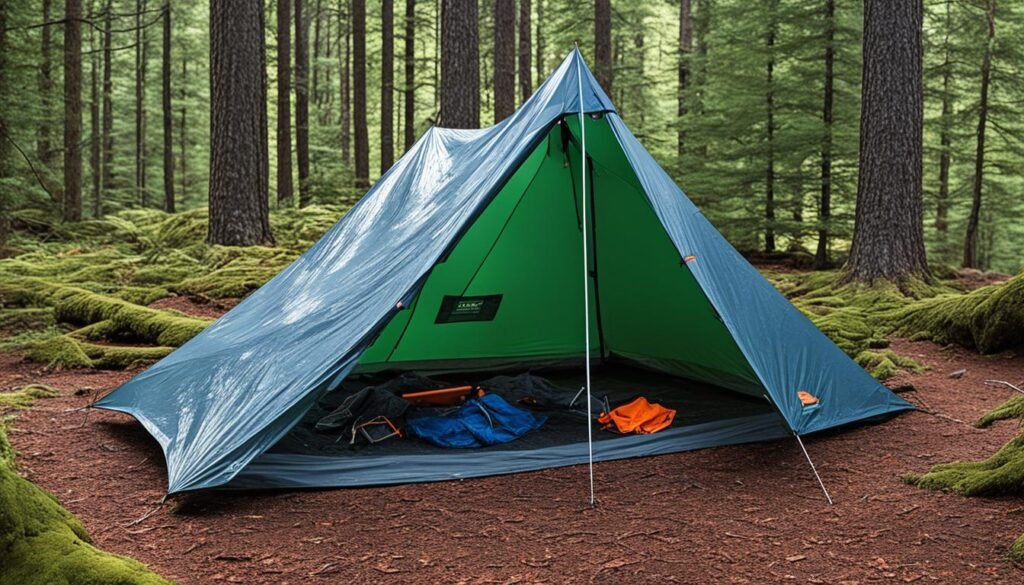As an avid camper who treasures the connection with nature, I’ve always been passionate about leaving as minimal an impact on the environment as possible. In the beautiful and delicate terrains of the White Mountains National Forest in New Hampshire, I’ve learned to adapt my camping methods to preserve the fragile alpine ecosystem. Here, you can’t just stake your tent anywhere you like. The rugged terrain mandates the use of established sites with wooden tent platforms. Initially, these platforms posed a challenge for my non-free-standing tent, which usually requires a meticulous stake-based setup to ensure stability.
However, through experience, I’ve discovered innovative, stake-free tent setup methods that both respect the environment and provide the durability needed to withstand the elements. I want to share my insights on how to secure a tent without stakes, a valuable skill for any nature enthusiast. Whether through leveraging anchored platforms, utilizing natural resources like rocks and sticks, or by adopting advanced techniques suitable for various environments, achieving tent stability without stakes is an art unto itself—one that enhances the outdoor experience while maintaining an eco-conscious approach.
Key Takeaways
- Mastering the technique of stake-free tent setup is essential in environments like the White Mountains National Forest.
- Wooden tent platforms are indispensable for securing tents without impacting fragile ecosystems.
- Using natural materials, such as sticks and rocks, can effectively anchor tents in the absence of traditional stakes.
- Adapting to the camping site’s conditions allows for both secure tent placement and environmental preservation.
- Collaboration with other campers and caretakers can be a significant asset in achieving a successful setup.
- Stake-free options offer additional amenities like water sources, bear boxes, and convenience, providing an enhanced camping experience.
Understanding the Challenges of Stake-Free Tent Setup
As a seasoned camper who has visited various preserved natural spaces, I’ve encountered my fair share of scenarios that require alternative tent securing methods. These situations have taught me the importance of understanding the unique properties of the land I am interacting with, recognizing that standard staking options sometimes pose threats to delicate ecosystems or simply aren’t effective due to incompatible ground conditions.
In my venture to achieve tent stability without stakes, I’ve experienced firsthand the challenges of securing a tent without stakes. Rock slabs, for instance, offer no give for traditional stakes, leading me to adapt by testing different anchoring strategies. Even substrates like soft sands can shift and slide under pressure, presenting another layer of complexity to my staking-free approach.
During a recent trip, I came across a site with a composite substrate of shallow sod layered above a rocky base. This sort of terrain restricts not only the types of stakes one can use but also limits penetration depth. Dense vegetation and rooty soils further add to the complexity of anchor placement. Each of these challenges has driven me to deeply analyze the physical and chemical properties of surfaces to anticipate their reaction to tension and pressure from tent anchors.
To comprehensively discuss these issues, let’s delve into specifics with a table that outlines the various substrates encountered and their associated securing strategies:
| Substrate Type | Challenges | Securing Method |
|---|---|---|
| Rocks and Slabs | Cannot penetrate with stakes | Utilize natural crevices; employ tension with ropes |
| Soft Sands | Shifts under stake pressure | Use wider-based anchors, like weighted bags |
| Shallow Sod over Rock | Limited depth for stakes | Deploy surface tension anchors like rocks and branches |
| Dense Vegetation | Difficult to clear or penetrate | Anchor to existing, secure vegetation or utilize tension systems |
| Rooty Soils | Stakes may damage roots or cannot be driven deep enough | Choose thin titanium nails or wire stakes that can navigate roots |
Each encounter with a new substrate leads to an evolving knowledge in tent stability techniques without stakes. My goal in sharing this information is to arm fellow campers with the knowledge to secure their shelters, maintaining comfort and safety without compromising the integrity of our beloved natural spaces.
Is Stake-Free Setup Better Than Using Stakes to Secure a Tent?
Yes, staking a tent securely is crucial for stability in windy conditions. However, some argue that stake-free setups like using weighted sandbags or tensioned guy lines offer easier and more versatile options. Ultimately, the best choice depends on the specific camping environment and personal preferences.
How to Secure a Tent Without Stakes
Embarking on an outdoor adventure often requires setting up a shelter that’s stable, reliable, and integrated within the natural landscape. Key to this is knowing how to secure your tent while minimizing your environmental footprint. Going stake-free not only preserves the land but also enhances your camping experience by highlighting innovation and resourcefulness.
Wooden Tent Platforms: Leveraging Built Structures
Upon encountering the designated wooden tent platforms in New Hampshire’s White Mountains National Forest, the art of anchoring tents without stakes becomes crucial. These platforms present a viable alternative, providing a sturdy base to affix your shelter firmly. By strategically deploying small sticks, rocks, or even utilizing the existing metal rings on the platform, your tent can stand robust in the face of mountain winds without a single stake piercing the ground. This method is not only eco-friendly but also offers a secure solution that respects the region’s conservation efforts.
Utilizing Natural Resources: Sticks and Stones
When stakes are not an option, the use of natural resources becomes a practice of ingenuity. Around these platforms, the abundance of sticks, stones, and other natural elements can be leveraged to anchor down guylines. I’ve witnessed this technique ensure tent stability as effectively as any metal stake ever has. Rocks are particularly helpful, acting as hefty anchor points that resist wind with remarkable tenacity. Sticks, on the other hand, can be wedged within platform crevices to create natural tension points. This harmonious blend of nature’s gifts and human creativity underscores the essence of respecting the landscapes we enjoy.
Adapting to Alpine Conditions: Advanced Techniques
In the alpine terrain, where environmental parameters demand non-traditional approaches, securing a tent becomes a test of adaptability. The limited space and rigid structure of the wooden platforms may pose initial doubts about attaining a taut tent setup. However, with patience and a willingness to experiment, one can develop advanced techniques that further reinforce tent stability. Whether wrapping guylines around larger boulders or creating intricate rock-and-stick combinations, the goal remains the same: to achieve a solid setup that stands firm against the unpredictable alpine climate, all while preserving the pristine nature around us.
Alternative Tent Securing Methods Across Diverse Terrains
Engaging with nature’s diverse landscapes often requires a departure from traditional camping setups. Securing a tent on diverse terrains has compelled me to learn and apply a broad spectrum of non-stake tent anchoring methods. I’ve embraced the necessity to adapt, cultivating an assortment of terrain-specific tent securing techniques able to handle anything from the rigid bedrock of alpine peaks to the shifting sands of desert dunes.
In this journey, I’ve continually tested and refined various methods, and I want to share a table summarizing some of the most effective securing strategies I’ve implemented across different terrains:
| Terrain Type | Challenges | Securing Methods |
|---|---|---|
| Solid Rock & Slabs | Stake penetration inability | Natural crevices for anchoring; weighted bags; rope tension techniques |
| Hard & Compact Soils | Requires significant force for stakes | Modified deadman technique using nearby stones or embedded objects |
| Loose Sand & Snow | Stakes easily displace | Deadman anchors using buried stakes or bags tied to guylines |
| Riverbanks & Gravel | Variable sizes of stones; soft edges | Tension systems around large rocks or taut-line hitches directly to boulders |
| Vegetative & Rooty Grounds | Roots obstruct stake penetration | Thin titanium stakes navigated between roots; utilizing solid tree bases as anchor points |
For instance, when faced with a vast expanse of solid rock, traditional stakes are utterly ineffective. Instead, I turned to the uninhibitiveness of rocks themselves, either by lodging guylines in their natural grooves or by leveraging weighted bags as staple anchoring points. These alternative securing methods provided a reliable and environmentally considerate solution.
Mastering the art of securing a tent using non-traditional methods not only enhances the camping experience but preserves the natural beauty we strive to immerse ourselves in.
When the ground comprises hard and compact soils, the modified deadman technique comes into its own. Here, surrounding rocks and other heavy objects serve as pivotal anchor points, to which guylines can be attached, thus ensuring the tent’s stability without the need to disrupt the terrain with stakes.
In snow or on soft sand—environments where stakes can easily lose their grip—the concept of deadman anchors shines. A buried stake, bag, or even a piece of driftwood attached to a guideline adeptly creates an immovable anchor under the surface, allowing for a tensioned and secure set-up.
Moving to riverbanks and gravel-rich areas, the unpredictable mixing of soil and stone sizes complicates staking. I’ve learned to rely on tension systems, ingeniously securing my shelter around larger, stationary rocks or looping ropes directly around immovable boulders with hitches that ensure a taut alignment.
Lastly, in environments rich in vegetation, with roots sprawling like nature’s web, staking becomes a careful negotiation with the living terrain. Thin titanium stakes, carefully inserted to avoid root damage, or the use of tree bases as natural anchor points, offer a means to responsibly interact with these dynamic substrates.
Implementing these methods requires a combination of patience, creativity, and respect for the environment. By understanding and adapting to the characteristics of each terrain, campers can achieve a secure and sustainably cozy haven in nature’s multifaceted playground.
Maximizing Tent Stability on Rock Slabs and Hard Surfaces
Setting up camp on the unyielding surfaces of Tasmania’s solid granite landscape has taught me valuable lessons in tent stability. Here, ordinary stakes are useless, pressuring me to discover alternative anchoring methods that are as effective as they are ingenious. In this rugged environment, solid granite anchoring becomes an exercise in creativity and resourcefulness.
Securing on Solid Granite in Tasmania
In Tasmania’s breathtaking yet challenging topography, the firm embrace of solid granite demands a specific approach to tent setup. The usual sharp jab of a metal stake is met with unwavering resistance from the ancient bedrock. To transcend this impasse, I’ve adopted a modified deadman technique, maximizing tent stability using the landscape’s own stability. Titanium wires and mini Groundhog stakes, known for their resilience, come into play when dealing with the equally stubborn, yet occasionally penetrable, hard soils.
Anchor Points: Making Use of Nature’s Gifts
My experience with rock slab tent securing has been one of profound learning and adaptation. Where the granite slabs extend like a vast unbreakable shield across the wilderness, I resort to nature’s gifts—mighty boulders and hefty logs, transformed into reliable anchor points. By making use of line extensions and tying down to these natural features or staking into the base of dense vegetation, I reinforce my tent against skyward aspirations. The rock slab’s refusal to yield to stakes becomes irrelevant in the face of natural anchor points that blend seamlessly into the landscape, ensuring both stability and respect for the indomitable terrain.
Embracing the challenges presented by solid rock surfaces not only tests my resourcefulness but also deepens my respect for the enduring might of nature.
The Art of Using Guylines for a Secure Setup
Mastering the art of guylines is like weaving a tapestry that binds the tent to the land. In environments where the traditional punch of a stake is not viable, I’ve come to rely on the subtleties and strengths of guylines for tent stability. These unassuming cords serve as integral sinews, anchoring the fabric home to earth through strategic tension and ingenious attachment points.
The efficacy of guylines is predicated upon their length, stretch, strength, and absorbency. Each of these attributes plays a pivotal role in the structure’s resilience against nature’s whims. In my hands, guylines become dynamic tools, malleable to the needs of the terrain, providing steadfast assurance against gales and gravity’s persistent tug.
When it comes to diverse substrates, my method is to tailor guylines meticulously to ensure unwavering tension and integrity. Whether wrapping around granite boulders or latching onto stout branches, guylines tent securing methods have transformed into an eloquent ballet of physics and precision. With an array of knots and fastenings at my disposal, the guylines’ hold is only as secure as my ability to manipulate their form to the landscape’s function.
Here’s a visual guide to the various tying techniques and their applications on differing substrates:
| Tying Technique | Best Used For | Why It Works |
|---|---|---|
| Bowline Knot | Secure, non-slip loop | Reliable under load, easy to untie after being weighted |
| Clove Hitch | Attaching to poles or trees | Easy to adjust, distributes load evenly |
| Taut-Line Hitch | Adjustable tensioning | Allows for quick adjustments to line tension in changing conditions |
| Prusik Knot | Attaching guylines to a main line | Moves smoothly when not under load, but grips snugly under tension |
| Figure-Eight Knot | Creating a secure stopper | Prevents the line from slipping through retainers, easy to inspect |
At the foundation of guylines tent securing methods is a deep respect for the environment and the contours of every distinctive landscape. Through the assembly of this complex network of lines, the task at hand is two-fold: construct a sanctuary against the caprices of nature without leaving an indelible mark upon her. This balance I seek, leveraging tradition with adaptation, is the essence of a conscious and masterful outdoor practice.
Guylines are the silent guardians of our canvas havens, holding firm against the push of the wind and pull of the ground, orchestrating a symphony of strength and flexibility.
As I traverse various grounds, from the alpine zones to the desert’s embrace, it is the guylines that afford me a constancy of shelter. They are more than merely cords; they are strands of assurance, the silent architects of the nomadic home.
Non-Stake Tent Anchoring Methods: When Stakes Just Won’t Do
When staking is off the table due to unyielding terrain or environmental preservation rules, I’ve always sought out non-stake anchoring methods that ensure my tent remains secure. In these situations, the ground itself becomes an ally, providing alternative anchor points that are both ingenious and effective. Let’s explore two such techniques that I count on to stabilize my shelter.
The Modified Deadman Technique
On surfaces where stakes fail to penetrate, the modified deadman technique is my go-to method. This method involves burying an object, often sourced from the environment such as a rock or a heavy piece of wood, and using it as an anchor for my tent’s guylines. By digging a shallow trench, placing the object within, and running a line from my tent through the anchor before carefully covering it again, I create a secure and hidden point of resistance against the wind.
Double-Staking with Alternative Tools
Another approach I employ in demanding situations is the double-staking technique, an effective tactic in terrains where increased holding power is paramount. I might not have the ability to drive a stake deep into the ground, but by combining two stakes, perhaps a shorter, more robust stake crossed over a longer, thinner one, I multiply their holding force dramatically. Guided by the necessities of the substrate, these non-stake anchoring methods prove to be adaptable and reliable.
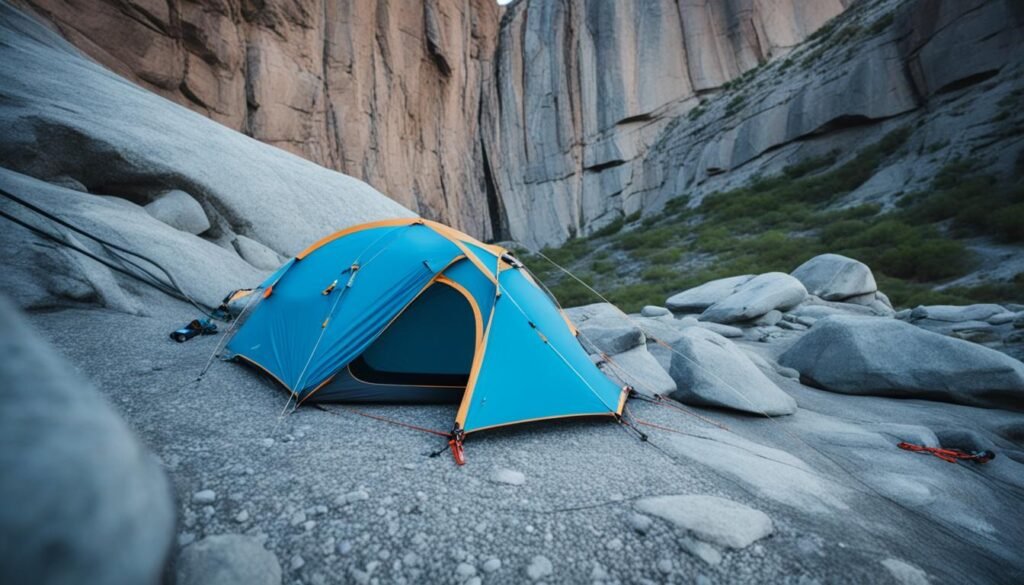
In practice, both the modified deadman and double-staking techniques manifest the essence of adaptability. By anchoring my tent effectively without traditional stakes, I embrace the challenge of various terrains, all while maintaining a commitment to environmental stewardship.
It is through the intelligent application of these alternative anchoring strategies that I’m able to secure my tent, confident in the knowledge that I’ve left no trace and upheld my pact with the wilderness.
Employing Tent Tie-Down Options for Sand, Snow, and Gravel
When you’re faced with the shifting surfaces of sand, the cold expanses of snow, or the loose pebbles of gravel, the usual methods of securing a tent with stakes become a moot exercise. In these landscapes, where stakes may fail to provide a solid hold, I’ve come to rely on a set of tie-down options for tents that are specifically suited to withstand the unique conditions these substrates present. My go-to solution in these environments is the strategic use of deadman anchors — a technique that involves burying an object which then serves as a solid point of attachment for a tent’s guylines.
To elucidate these methods, let me present an overview of the various tie-down options I’ve employed, highlights of their effectiveness, and situations where each has been most applicable. The objective with these strategies, such as deadman anchors, is to distribute tension throughout the tent structure, keeping it firmly grounded despite the seeming capriciousness of these substrates like sand, snow, or gravel.
| Tie-Down Method | Best Used For | Description | Benefits |
|---|---|---|---|
| Buried Stakes | Sand and Snow | A conventional stake buried horizontally to create an anchor | Maximizes the stake’s surface area for better grip |
| Weighted Bags | Gravel and Scree | Bags filled with available materials act as an anchor when tethered | Adaptable and use substances from the immediate environment |
| Natural Deadman | Sand and Snow | Items like wood or rocks buried to secure guylines | Eco-friendly option that leaves no trace |
| Anchor Plates | Gravel and Harder Snow | Metal or durable plates with holes for guylines | Provides a broad, solid base for guyline attachment |
In my experiences, employing these gravel tent anchoring or sand and snow tent securing methods has proven effective in maintaining the stability of my tent. A buried bag filled with sand, for instance, becomes a steadfast anchor in a dessert camp, while a buried wooden plank does wonders on snowfields. Staying rooted in these often fine and granular substrates is about more than just improvisation; it’s about understanding the dynamic forces at play and respecting the landscape by utilizing what it offers to secure a temporary dwelling without disrupting the natural setting.
To campers and adventurers alike, remember this: the essence of our explorations is not solely to experience the unfettered beauty of the outdoors but to interact with it in a way that allows us to leave it as untouched as we found it. By mastering these tent tie-down options, you’re not just ensuring a restful night’s sleep but conserving the integrity of the wild spaces we cherish.
Innovative Stake-Free Tent Securing Strategies
Out in the wild, traditional tent staking methods aren’t always an option, especially in environments where the ground is too hard or stakes are prohibited to protect the terrain. This is where innovative tent securing strategies come into play, allowing me to enjoy a stake-free tent setup even in challenging conditions. Over time, I’ve honed a variety of creative tent anchoring methods relying on the surrounding environment to hold my tent in place safely and responsibly.
One staple method involves the use of weighted bags as anchors. Filling bags with local materials, such as sand or stones, provides enough weight to keep a tent grounded. I’ve used this approach on numerous occasions, particularly on beaches and in desert landscapes where the soil is loose and stakes can’t be driven deep into the ground.
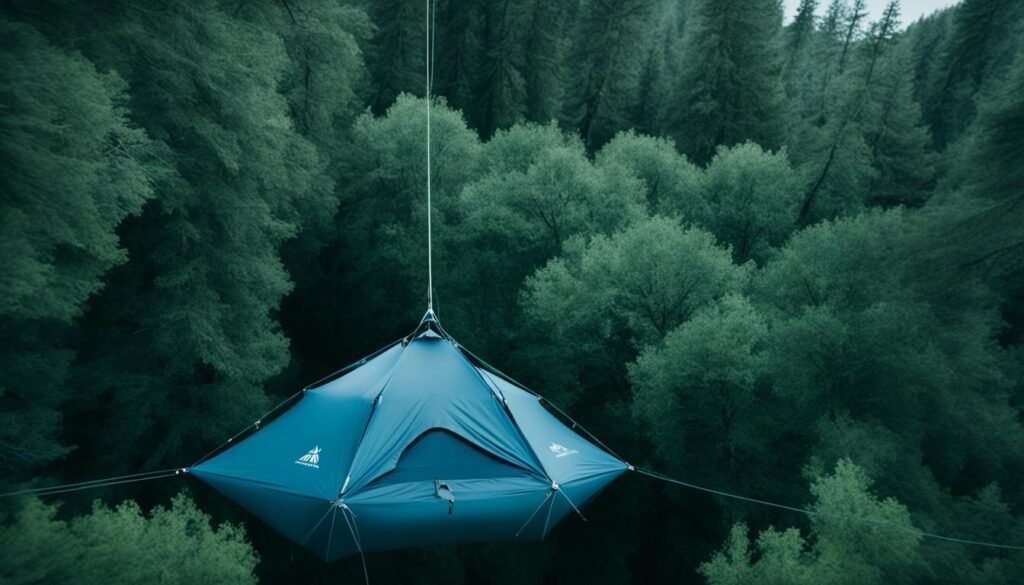
Another strategy is to make use of naturally occurring features like boulders or logs. Large rocks, often found scattered around the campsite, can be strategically placed at key tension points to prevent the tent from blowing away. Similarly, logs can be laid across guylines or used as a counterbalance to maintain the tent’s structure. It’s a perfect marriage of nature’s provisions with camping ingenuity.
By using what nature offers, I resolutely anchor my shelter without leaving a trace on the environment I’m there to appreciate.
- Employing weighted bags filled with local materials to anchor the tent.
- Pairing naturally occurring features like heavy rocks or logs with guylines for stabilization.
- Optimizing the landscape’s inherent assets to create a secure, sustainable campsite.
It’s not just about finding alternative ways to secure a tent but about being mindful of my impact on nature. These stake-free tent setup techniques are more than just convenient; they reflect a commitment to preserve and protect the precious ecosystems that host my outdoor adventures.
Adapting Tent Securing Techniques for Sensitive Environments
As I navigate through my camping adventures, I’ve become increasingly aware of the delicate balance required when tent securing in sensitive environments. Traditional staking methods can wreak havoc on fragile ecosystems, an outcome I am committed to avoiding. Therefore, I’ve embraced the adaptation of tent securing techniques to ensure not only my safety but also the preservation of the pristine settings I inhabit.
My environmentally friendly tent setup starts with the utmost respect for the natural surroundings, which means altering conventional methods to minimize my impact. For instance, anchoring my tent to sturdy, established trees or sizeable rocks has proven to be an effective strategy without inflicting harm on the land.
Taking this a step further, I’ve often employed built tent platforms, specifically designed to accommodate tents without the need for stakes, which alleviates the pressure on the terrain beneath. However, adapting to these platforms required a different set of skills and some creative thinking.
To illustrate my point, let me share a specific example of a stake-free setup on a camping trip within an environmentally sensitive area:
| Element of Setup | Method Used | Reason for Selection |
|---|---|---|
| Anchoring Points | Trees and Rocks | Use of natural features causes no ground disruption |
| Platform Utilization | Metal Rings & Grooves | Pre-existing structures designed for minimal impact |
| Weather Resistance | Guylines & Weighted Objects | Provides stability in adverse conditions without stakes |
| Environmental Impact | Leave No Trace Principles | Ensures the area remains undisturbed for future visitors |
During my time in heavily regulated locations such as White Mountains National Forest, I’ve repeatedly called upon my knowledge and creativity to stabilize my shelter. By utilizing rocks and dense branches found in the vicinity of my campsite, I’ve been able to secure my tent with guylines, always intertwining responsibility with ingenuity.
Immersing myself in nature’s canvas without altering its essence is the core philosophy behind the techniques I’ve adopted for securing tents in protected environments.
In my continuous endeavor to adapt to diverse landscapes, I have come to understand that every campsite presents its own set of limitations and possibilities. Whether I’m alighting upon the banks of a tucked-away alpine lake or settling in the midst of towering forests, I ensure that my presence is transient – a mere whisper on the wind safeguarded within the bounds of nature’s grand design. Embracing stake-free securing practices is not just camping; it’s a commitment to the conscientious enjoyment of our wonderful, wild world.
Tent Anchoring Without Stakes: Dealing with Dense Vegetation
When camping in areas with dense vegetation, such as alpine buttongrass or expanses of tussock, traditional methods for anchoring tents using stakes quickly become ineffective. Here, the reach of standard stakes is impeded by the robust flora. Instead, my adaptability is tested as I seek out innovative ways for anchoring tents in dense vegetation, ensuring stability for a restful night’s sleep amidst nature’s lush complexity.
Pitching on Alpine Buttongrass and Tussock
In locales where the landscape is swathed in alpine buttongrass, stake penetration is often shallow, if not downright impossible. This is where the art of tent setup on tussock and rooty substrates is honed. To secure my shelter here, I opt for thinner stakes or guylines with line extensions that cleverly navigate and grip within the dense foliage, achieving a firm grip where one would not expect it.
Navigating Rooty Substrates and Tree Roots
Similarly, in areas replete with intertwining roots, using broad or thick stakes can cause harm to this delicate subterranean network. My approach becomes cautious, utilizing slender titanium nails or wire stakes that thread through the soil matrix with minimal disturbance. In situations where even these tools meet resistance, I become reliant on the surrounding environment, fashioning anchor points from the very roots and vegetation that present the challenge.
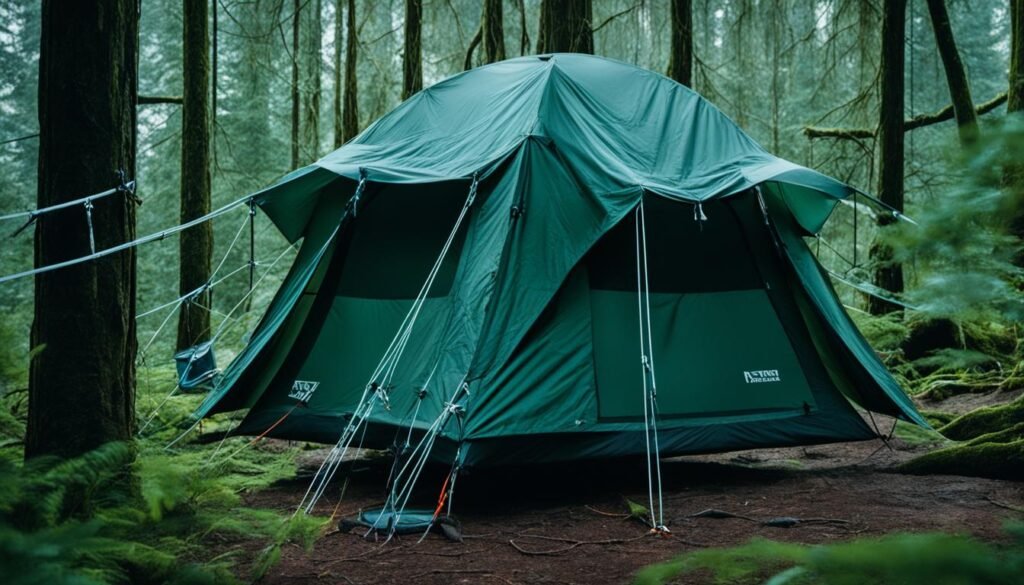
As can be seen in the ecosystems that challenge conventional camping setups, the approaches for anchoring tents in dense vegetation are varied and steeped in respect for the environment. The essence of pitching tents on alpine buttongrass, or any tent setup on tussock and rooty substrates, lies in a gentle ingenuity that harnesses the natural surroundings to provide stability and sanctuary. By merging adaptability with an uncompromising ethos of conservation, my camping practices honor the beauty and complexity of these rich biomes while also ensuring my temporary dwelling is reliable and secure.
Reinventing the Traditional Tent Setup: Platforms and Pads
When faced with the challenge of a traditional tent setup on platforms, the game of outdoor lodging changes entirely. The common method of driving stakes into the earth is replaced by the innovative stake-free securing on decking, a testament to adaptability and ingenuity in the great outdoors.
Camping on timber decking, often found in picturesque sites designed to minimize environmental impact, presents a unique set of challenges and opportunities. Narrow gaps between decking slats and often-present perimeter chains or nails beckon inventive use for attaching guylines. This strategy leverages existing structures to secure tents, which is not only prudent in preserving the natural terrain but also offers a degree of convenience and ease.
Furthermore, some designated campgrounds offer tent pads and platforms made from fibreglass reinforced plastic (FRP) grating, a material that doesn’t conform to the traditional methods of stake usage. Here, lighter stakes with broad surface areas come to the forefront, providing the needed grip on these homogenous surfaces designed to hold a tent in place without causing damage or requiring penetration.
In addressing the challenge of ensuring a reliable setup on such specialized materials, I have found that staples of outdoor gear—specifically guylines and tension systems—prove to be incredibly versatile. By creatively utilizing the natural tension of these lines and the inherent features of the platforms, I can enjoy a stable and secure lodging experience. The techniques I’ve mastered are detailed in the following table, which serves as both a practical guide and an ode to adaptable camping:
| Feature | Securing Technique | Material | Adaptation Benefit |
|---|---|---|---|
| Decking Slats | Guylines woven through | Wood | Utilizes the platform’s design without altering its structure |
| FRP Grating | Light stakes with wide heads | Fibreglass | Ensures grip on smooth surfaces without drilling or damage |
| Perimeter Chains/Nails | Guylines attached | Metal | Affords a secure tether point for stability |
These adaptations to traditional tent setup on platforms are not merely a workaround but a pronounced evolution of the camping craft. It’s a bridging of tradition with modern stewardship, where the preservation of the terrain takes precedence. I relish the chance to employ these methods, broadening my spectrum of camping expertise while maintaining a respectful relationship with nature.
How to Secure Your Tent Indoors or on Hard Surfaces
When the great outdoors beckons, yet circumstances lead us indoors, the adventure of camping need not be shelved. The quest then becomes one of securing tents indoors, or onto hard surfaces where conventional stakes are of no avail. In this realm, the bell tent—a symbol of versatility—can be perfectly adapted for indoor environments or on unyielding surfaces, ensuring a steadfast setup for any temporary indoor tent space.
Setting Up a Bell Tent Without Pegs Indoors
In situations where setting up a bell tent on soft ground isn’t possible, such as indoor settings or on solid, hard surface tent anchoring becomes a creative endeavor. By utilizing weighted bases, the familiar bell tent setup without pegs is transformed. This process requires attaching the tent’s floor stake points and guy-lines to sturdy wooden boards, each equipped with robust hooks to support the structure.
Here’s how it’s done: each floor stake point of the bell tent is connected to a wooden board using a durable hook. Sandbags, generally weighing around 35 pounds, are then placed on the board to anchor it down. This not only secures the bell tent but also preserves the integrity of indoor flooring or the hard surface below.
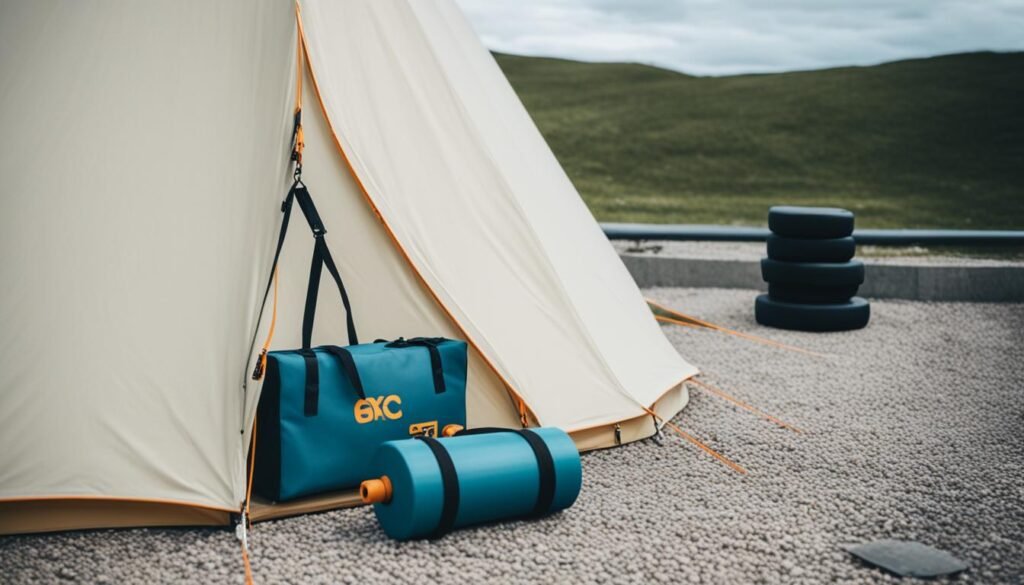
Creating a Temporary Secure Indoor Tent Space
For event planners or glamping aficionados looking to recreate the magic of camping indoors, fashioning a temporary secure indoor tent space can be achieved with elegance. Each wooden board acts as a replacement for a peg, neatly hooking into the tent’s D-rings. Sandbags, strategically positioned on the board, offer gravity’s grip in lieu of the earth’s embrace. The result is not only practical but stylish, maintaining the bell tent’s sweeping silhouette.
To further accentuate the tent’s inherent beauty while reinforcing its structure, alternative weights can be utilized. Whether your aesthetic leans towards the rustic charm of logs, the industrial simplicity of cinder blocks, or the luscious appeal of potted plants, your choice in weights can enhance the tent’s appearance whilst fulfilling its functional role. For indoor spaces or concrete expanses where bells tent should harmonize with the environment, even shot bags can be employed as inconspicuous but powerful anchors.
These methods of securing tents indoors present a sustainable paradigm, reducing the reliance on invasive anchoring methods and preserving the surfaces on which the tent is erected. The absence of stakes, far from being a hindrance, becomes an opportunity to innovate and adapt, drawing on resourcefulness and responsible stewardship over the environments we inhabit, even if temporarily.
Whether setting up for a trade show, a festival, or a special event, this stake-free anchoring system ensures a bell tent is as regal and grand indoors as it is under the open sky. The underlying philosophy here is simple: it’s not about the traditional methods we use, but the stability and grace with which we adapt to our surroundings.
Conclusion
The art of a secure tent setup without stakes is an essential skill for modern adventurers and event planners alike. Through the compilation of various tent securing tips without using stakes, this guide has explored diverse methods and terrains, and has showcased that a stable temporary home is within reach, regardless of the environmental conditions or restriction of traditional staking methods. From the wooden platforms in the White Mountains to the impenetrable solid granite of Tasmania, and onto the smooth surfaces used for indoor events, stake-less tent securing strategies have demonstrated not only feasibility but resourcefulness.
Alternatives to tent stakes have been presented as inventive solutions that engage with the environment thoughtfully and with consideration. The juxtaposition of wooden boards weighted with sandbags for indoor use, against utilising rocks, logs, or dense vegetation for outdoor anchoring, speaks volumes of the versatility and creativity embedded in modern camping practices. These methods do not merely serve as functional anchors; they are embodiments of an attitude that prioritizes harmony with nature, adaptability in the face of challenges, and a dedication to the Leave No Trace principles.
In conclusion, my experiences have taught me that achieving a secure tent setup without stakes is not just about conquering challenging conditions—it’s about embracing those challenges as opportunities to innovate while cautiously respecting the beautiful and often fragile natural world we are privileged to enjoy. From individual campers to professional organisers, this document aims to equip you with knowledge for a reliable stake-free tenting experience that aligns with our collective responsibility to preserve the great outdoors for generations to come.
FAQ
What are some alternative tent securing methods when stakes are not an option?
Alternative tent securing methods include using heavy objects like rocks, bags filled with sand or stones, tying off to trees, leveraging natural features, or utilizing built structures like wooden tent platforms to anchor guylines or attach to metal rings.
Can you provide tips for securing a tent without using stakes?
Yes. Use natural resources like heavy rocks or logs to anchor your tent or attach guylines to sturdy trees. You can also use snow or sand anchors in softer terrain, or employ line extensions to reach more stable anchor points when you need to secure your tent in challenging environments.
How can I maximize tent stability on a rock slab or hard surface?
To maximize tent stability on rock slabs or hard surfaces, use tensioning techniques with guylines, anchor to adjacent boulders or vegetation, and consider using the modified deadman method where you bury a stone or log as an anchor. Creative use of the natural environment aids in adapting to these surfaces.
Are there specific strategies for setting up tents on wooden platforms?
For setting up tents on wooden platforms, you can use small sticks, rocks, or tie ropes to the metal rings often found on the sides of the platforms. Carefully positioning these materials can help achieve the necessary tension for stability.
What is the modified deadman technique in tent anchoring?
The modified deadman technique involves burying a stake, rock, or log horizontally in the ground, then attaching a guyline to it. This provides an effective anchor in soft or loose substrates where conventional stakes would not hold well.
How do guylines contribute to tent stability?
Guylines extend from the tent fabric and are anchored to the ground or other points to provide lateral stability, countering wind force, and preventing collapse. They are crucial for maintaining the tent structure when stakes cannot be used.
What are some stake-free tent securing strategies?
Stake-free tent securing strategies involve using tie-down options like weights, leveraging environmental features like trees and rocks, or using specialized equipment like sand/snow anchors, wooden boards with weight for indoor setups, and modified staking techniques suited to the terrain.
How can I secure my tent in a sensitive environment without causing damage?
In sensitive environments, minimize the environmental impact by using existing natural features like trees or rocks for anchoring points, employing non-invasive methods like weighted bags, or setting up on pre-established platforms that provide secure anchor points without ground penetration.
How do I pitch a tent in dense vegetation, such as alpine buttongrass?
Pitching a tent in dense vegetation like alpine buttongrass requires stakes or anchors that can penetrate through the vegetation into the soil or leveraging sturdier plants as natural anchors. Line extensions may be useful to reach firmer ground beyond the immediate vegetation.
Can I set up my tent on platforms like FRP grating or timber decking without using stakes?
Yes, you can set up a tent on platforms like FRP grating or timber decking by using gaps in the decking or rings on platforms to secure guylines. Sometimes perimeter chains or hardware attached to these platforms can also be used for anchoring.
What are the best ways to secure a tent indoors or on other hard surfaces?
To secure a tent indoors or on hard surfaces, use weighted bases like sandbags attached to the tent’s pull points, wooden boards with weights and hooks, or other heavy objects to maintain stability without the need for stakes penetrating the floor.
What are some environmentally friendly tent setup alternatives to using stakes?
Environmentally friendly alternatives to using stakes include utilizing natural anchors like rocks and logs, weighted bags, securing to sturdy vegetation without harming it, and using existing structures like tent platforms that don’t require ground penetration.

